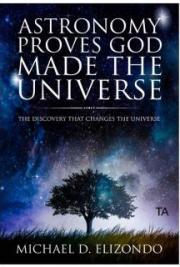ON THE INTERSTELLAR TRAVEL
A book on Information Physics
By Sergio Michelson © 2014-2016. http://spacetravelscience.com/
Because a fact seems strange to you, you conclude that it is not one. ... All science, however, commences by being strange. Science is successive. It goes from one wonder to another. It mounts by a ladder. The science of today would seem extravagant to the science of a former time. Ptolemy would believe Newton mad. -Victor Hugo
Introduction
In this book we will develop a new approach to fundamental physics. It presents a different explanation for experimental findings that lie at its core. We call it Information Physics. As its name suggests, it is built around the concept of information. The notion of information is applied to fundamental physics in a way that is different from the current information theory, also known as Shannon's theory.
Information Physics is a scientific theory because it explains experimental results stretching back hundreds of years. It also gives new predictions that can be tested. It is an alternative to a Relativistic point of view.
Overview
Information Physics starts by intentionally ignoring Relativity, Quantum Mechanics and Newtonian physics, but reducing to all of them as a special case. The idea is that information plays a more fundamental role in Nature than we currently suspect.
One prediction of Information Physics is a physical possibility of faster-than-light motion in deep space, under conditions that cannot be achieved near large mass such as Earth or the Sun.
Because Information Physics starts before the first principles, which includes Relativity, Einstein's work is not debated, other than in a context of a historical frame of reference. For example, equations that look similar to that of Relativity are derived without it.
Information Physics uses only three-dimensional space and linear time. In order to explain relativistic phenomena, the need for more complex notions does not arise.
 This book isn't about philosophical aspects of information in Nature, but rather about its inner workings. The main topic is the throughput of information use in physical systems. In the latter part of the book, we will focus on its formal mathematical results.
This book isn't about philosophical aspects of information in Nature, but rather about its inner workings. The main topic is the throughput of information use in physical systems. In the latter part of the book, we will focus on its formal mathematical results.
What is in this book?
We will start with the basic idea of Information Physics, introduced by questions and analogies. This includes "Getting started" and "Information" chapters.
Next, we'll discuss some of the relevant theories, in these chapters: "Shannon and the concept of information", "Einstein's Relativity" and "Quantum Mechanics". We'll talk only in limited terms about these theories, as much as we need for our purposes.
The following chapter, "Information Physics", introduces the essential concepts in an informal manner.
In the chapter "Why space has three dimensions?", we'll mathematically derive that the number of dimensions should be three.
In "Unification by information" we'll deduce the basics of modern physics, in a way that is qualitative. We'll also talk about some of the predictions of Information Physics.
Following this, in "The Math: Proof of concept", we will show the simplified mathematical proof of Einstein's kinematic time dilation, without Relativity or a notion of light. We'll also generalize the math to show that Faster Than Light motion is possible.
"Speed of light" chapter will touch on the concept of maximum speed in Nature, and its relation to the speed of light.
The "Mass" chapter will talk about gravitational and inertial mass and their common origin, from the informational perspective.
In "Information Physics and the Principle of Uncertainty", the notions of uncertainty and quantizing are explained from a different standpoint.
"De Sitter effect without Relativity" qualitatively explains the effect that's considered one of the principal proofs of Relativity, by using informational approach only.
In the following chapter, "The Proof: Beyond Michelson-Morley", the pillar of Special Relativity is examined, including its flaws. Experiments to prove Information Physics are proposed.
In "FTL (Faster Than Light) Motion" and "Artificial Gravity", the reasons and circumstances of these predictions are explained.
We will lean toward informal narrative here. For the formal theory of Information Physics, please read it on the Web.
Getting Started
What would Einstein say?
One of the most striking effects of Relativity is time dilation. It means that clocks tick slower for a body in motion. For example, time for a space ship moving close to the speed of light would slow down to a crawl.
Usually time dilation is depicted as an upward curve, where the value for time dilation approaches infinity as the speed approaches c (or the speed of light, 300,000 km/s). Here's a typical diagram that shows why nothing can travel faster than light:

As you can see, time dilation would effectively slow down the passage of time to a standstill as the speed of light is approached. Other effects happen as well, such as mass increase, but as an illustration, let's stick with time dilation.
Here is a diagram that exemplifies how Information Physics generalizes the results of Relativity. It shows the circumstances of a practical faster-than-light motion, in a situation of a ship moving away from Earth:

We will derive it mathematically and explain the circumstances under which it holds. Einstein's physics becomes the left-most quadrant on the diagram. This quadrant represents our world. The other quadrants represent the deep space outside the world of massive bodies, like Earth.
 The factor f in the above diagram is called "information influence" and for everything we have done so far, it has the value of nearly 1. This includes all the experiments on, or near large bodies like Earth. However, this factor f becomes smaller and smaller the further away from Earth, and the larger the departing mass is.
The factor f in the above diagram is called "information influence" and for everything we have done so far, it has the value of nearly 1. This includes all the experiments on, or near large bodies like Earth. However, this factor f becomes smaller and smaller the further away from Earth, and the larger the departing mass is.
For example, the above diagram shows what happens to a large spaceship. Close to Earth, its maximum speed is limited to the speed of light (300,000 km/s). A good distance from it, factor f becomes one-half, and the maximum speed becomes double the 300,000 km/s. Still further away, factor f becomes one-third and the maximum speed becomes triple the 300,000 km/s, and so on.
While this is not in accordance with Einstein's Relativity, it doesn't have to be. Why?
The theory presented here is a generalization of Relativity. As such, it complies with experimental data, while suggesting new experiments. Einstein’s theory, when it comes to scenarios like this in deep space, is only a theory and has not been proven. In those scenarios, Einstein’s theory is a conjecture based on indirect experiments, such as those performed on tiny particles here on Earth. In other words, we assume that Relativity will hold, but we don’t know for sure. Our theory says we’re in for a surprise.
The problem with laws of physics
Consider a train of thought in the form of Q&A that depicts the current view:
Step 1: Why do we have laws of physics?
Step 2: To explain non-random behavior in Nature.
Step 3: Why is there non-random behavior in Nature?
Step 4: It's because of laws of physics.
Step 5: Go to Step 1.
The above is, of course, a circular reasoning. Unfortunately, today's physics has nothing better to offer. The question of why everything in Nature isn't random remains.
Physical laws do not explain that. They describe the behavior we find in Nature, but they do not explain why would there be any behavior that requires explaining.
Information Physics, Relativity, QM and "It from Bit"
Information Physics brings together the two disparate views of modern physics: Relativity and Quantum Mechanics. It replaces the foundations of Relativity and Quantum Mechanics with a new concept of information.
For that reason, the theories of Einstein and Heisenberg are not argued, but rather, are derived as a special case of Information Physics.
This makes Information Physics different from any other attempt to place information at the core of physical reality, including before and after the It From Bit paradigm.
It's different because all other theories cannot account for Relativity. None accounts for Quantum Mechanics. And none produces experimentally verifiable results that diverge from both. That's what's needed for something to be called new physics.
What is Information Physics?
To begin with, the usual concepts you'd expect are missing. There is no mass, light, gravity, energy or force, and no principles of Relativity and Quantum Mechanics.
If you think about all these, the complexity is staggering. Is it likely that the Universe would start off with all of them? Or would it likely start with a much simpler foundation?
Modern physics rests on a general premise that physical laws govern everything.
All the while, the question remains: why would there be physical laws? What is it that enforces the laws? How would a particle such as an electron know how to behave?
The answer is that only the use of information can produce non-random behavior. In plain language, a decision to act in a non-random way cannot




 This book isn't about philosophical aspects of information in Nature, but rather about
This book isn't about philosophical aspects of information in Nature, but rather about




